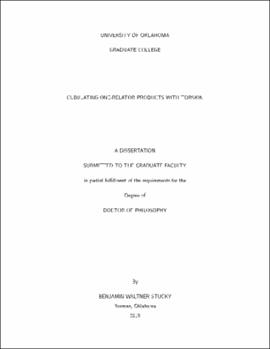| dc.contributor.advisor | Forester, Max | |
| dc.contributor.author | Stucky, Ben | |
| dc.date.accessioned | 2019-05-02T13:55:51Z | |
| dc.date.available | 2019-05-02T13:55:51Z | |
| dc.date.issued | 2019-05-10 | |
| dc.identifier.uri | https://hdl.handle.net/11244/319548 | |
| dc.description.abstract | Since the resolution of the virtual Haken conjecture in the theory of hyperbolic 3-manifolds, there has been much attention devoted to CAT(0) cube complexes. These non-positively curved metric spaces are powerful tools for understanding infinite, finitely generated groups in part because of their "cubical" combinatorics. Simply knowing that a group is cubulable (acts geometrically -- properly and cocompactly by isometries -- on a CAT(0) cube complex) is sufficient to unlock a good deal of structural information about it, and cubulating groups has become an important goal of modern geometric group theory.
In 2013, Lauer and Wise showed that a one-relator group with torsion whose defining relator has exponent at least 4 is cubulable. To achieve this, they build a system of nicely-behaved codimension-1 subspaces ("walls") in the universal cover and invoke a construction due to Sageev.
In this thesis, we achieve a generalization of this result to one-relator products with torsion, namely, that a one-relator product of locally indicable groups whose defining relator has exponent at least 4 admits a geometric action on a CAT(0) cube complex if the factors do. Our results are framed in the more general context of "staggered" quotients of free products of finitely many locally indicable and cubulable groups. The main tools are geometric small-cancellation results for van Kampen diagrams over these groups, which allow us to argue that walls are plentiful and geometrically well-behaved in the universal cover. Relative hyperbolicity of these one-relator products and relative quasiconvexity of wall stabilizers both play a central role.
Using Agol's theorem that a hyperbolic, cubulable group is virtually special, we obtain as a corollary that the one-relator products we consider are virtually special provided that the factors are hyperbolic in addition to the other assumptions. | en_US |
| dc.language | en_US | en_US |
| dc.rights | Attribution-NonCommercial-NoDerivatives 4.0 International | * |
| dc.rights.uri | https://creativecommons.org/licenses/by-nc-nd/4.0/ | * |
| dc.subject | Mathematics | en_US |
| dc.subject | Geometric group theory | en_US |
| dc.subject | Topological methods in group theory | en_US |
| dc.subject | Non-positively curved spaces and groups | en_US |
| dc.title | Cubulating one-relator products with torsion | en_US |
| dc.contributor.committeeMember | Jablonski, Michael | |
| dc.contributor.committeeMember | Tao, Jing | |
| dc.contributor.committeeMember | Greene, Scott | |
| dc.contributor.committeeMember | Brady, Noel | |
| dc.date.manuscript | 2019-05-01 | |
| dc.thesis.degree | Ph.D. | en_US |
| ou.group | College of Arts and Sciences::Department of Mathematics | en_US |
| shareok.orcid | 0000-0003-4293-6475 | en_US |
| shareok.nativefileaccess | restricted | en_US |

